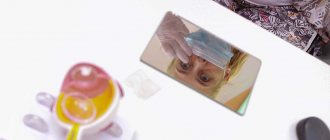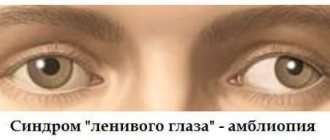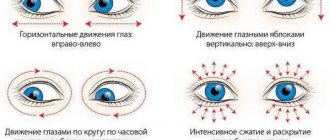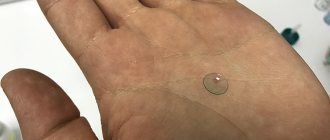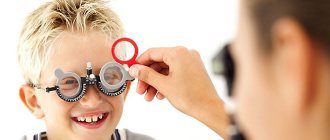Prevention of visual impairment in children
Take care of your eyesight from childhood. The human visual system continues to develop after birth, so it is necessary to follow the basic rules.
Tip 1. Prevention of visual disorders
Daily regime. Make sure your child follows a daily routine. During the day, alternate between different activities:
- The child should eat rationally, eat foods rich in vitamins and minerals.
- The child should walk in the fresh air more often.
- The child should sleep in a well-ventilated room for at least 10 hours.
Visual mode.
- The child should be directly in front of the TV (computer) screen at a distance of 2 to 5 meters.
- The duration of continuous viewing of television programs (working or playing at the computer) is 30 minutes.
- The duration of classes at home is from 40 minutes to 1 hour.
Workplace.
- The workplace must be appropriate for the child's height and well lit.
- During classes, make sure that your child keeps his torso and head straight and his shoulders straight.
Tip 2. Examination by specialists over time
Constant observation by an ophthalmologist allows for timely detection of visual impairment and initiation of medication, device treatment, glasses or contact correction. If a child puts on glasses for the first time or changes them to new ones, discomfort may appear, which is gradually eliminated after getting used to it.
Correctly selected glasses are comfortable and beautiful!
Do you need glasses? If, after a study, your child is diagnosed with myopia (nearsightedness), hypermetropia (farsightedness), astigmatism (incorrect image), then he sees the world around him like this:
Trust a specialist! A child must perceive the world as it is!
Tip 3. To prevent visual fatigue and visual impairment, do the following exercises with your child. Lesson duration: 5 minutes.
- Alternately, without sudden movements, look up and down, left and right. Repeat 5-6 times.
- Leaning back on the stupa, take a deep breath, lean forward and exhale. Repeat 5-6 times.
- Lean back in your chair, close your eyelids, close your eyes tightly, and then open your eyelids. Repeat 5-6 times.
- Place your hands on your belt - turning the head to the right, look at the elbow of your right hand, turning your head to the left, look at the elbow of your left hand. Return to the starting position. Repeat 5-6 times.
- Raise your eyes up, make circular movements clockwise, then counterclockwise. Repeat 5-6 times.
- Look straight ahead at a distant object for 2-3 seconds, move your gaze to the tip of your nose for 3-5 seconds. Repeat 6-8 times.
Characteristic
The main function of vision is to distinguish the shape, brightness, color, and size of observed objects. Along with other sense organs, vision plays a huge role in determining distances to an object and in regulating body positions.
The eyeball is a paired organ with a spherical shape.
Eye shells:
- External : cornea and sclera
- Vascular: iris, ciliary body and choroid
- Retina
The accessory apparatus of the eye consists of:
- Eye sockets
- Extraocular muscles
- Lacrimal glands, lacrimal ducts
- Conjunctiva
- Century
Central visual acuity is the ability of the eye to distinguish 2 points separately, which are located at a minimum distance from each other, but at a maximum distance from the eye.
The visual field is the space that is perceived by the fixed eye at the same time. Research methods: control, perimetry, campimetry. Types of pathology: narrowing of boundaries, loss of areas.
Color perception is the ability of the eye to distinguish colors.
Adverse factors that contribute to visual impairment:
- Hereditary predisposition, for example, high myopia in parents
- Excess body weight
- Carrying out work that requires eye strain in low light conditions
- Vitamin A deficiency
- Exposure to ultraviolet radiation
- Metabolic disorders
- Frequent viewing of television programs
- Sitting at the computer for a long time
- Sedentary lifestyle
- Unfavorable environmental conditions
- Prolonged sitting while working or studying.
The main symptoms of visual impairment in schoolchildren are fatigue, decreased performance, omission of words when reading, and common mistakes when writing. Prevention is useful due to the fact that in the future it helps to avoid diseases of the eyeball, blindness, and surgical intervention.
The most common forms of visual impairment:
- Myopia (myopia) : during the period of visual stress, changes occur in the eyeball due to circulatory disorders, which lead to its lengthening (stretching), resulting in deterioration of distance vision.
- Farsightedness : A congenital condition characterized by decreased near vision, eye fatigue, redness, and pain associated with visual performance.
- Astigmatism : is expressed in decreased vision both at distance and near, as well as decreased visual performance, painful sensations in the eyes and rapid fatigue when working at close range.
- Strabismus : due to dysfunction of the eye muscles. One healthy eye works, and the squinting eye is inactive, which gradually leads to a persistent decrease in vision.
↑ Top | Applying for treatment ↓
From 04.11.19 – to 13.11.19 A ten-day event is being held on the topic “Prevention of diseases of the visual organs.”
Eye health depends on the condition of the whole body. A healthy lifestyle - proper nutrition, control of blood pressure, cholesterol and blood sugar levels, as well as giving up bad habits will help maintain good vision into old age.
Protect your eyes with sunglasses
Ultraviolet radiation from the sun causes a number of negative changes in the eyes: it accelerates the development of cataracts and macular degeneration, and also causes damage to the cornea. Quality sunglasses block UV-A and UV-B rays and reduce glare for improved image clarity.
Monitor your blood sugar levels
Regular consumption of fatty and sweet foods leads to strong fluctuations in blood sugar levels and, as a result, to the development of type 2 diabetes. Serious eye diseases such as diabetic retinopathy, glaucoma and cataracts are associated with this disease. Fluctuations in blood sugar can also lead to changes in the lens and decreased vision.
Control your blood pressure and cholesterol levels
The combination of hypertension and high cholesterol levels in the blood damages the vessels that supply the retina. This is fraught with occlusion of its central artery, which completely impairs vision in the affected eye.
Eat foods rich in antioxidants
Regular consumption of foods rich in antioxidants significantly reduces the likelihood of macular degeneration and slows the development of cataracts. Vitamin A protects the retina and improves color and night vision. Sources of vitamin A in the diet include carrots, dark green leafy vegetables, spinach, broccoli, eggs, butter, milk, and cheese.
A simple recipe for improving vision: drink a glass of freshly squeezed carrot juice every day; for better absorption of vitamin A, you can add a little vegetable oil to it. Or eat carrot salad for breakfast, seasoned with sour cream or vegetable oil.
B vitamins reduce eye redness and light sensitivity. Contained in bread, cereals, milk, dark green vegetables, beans and peas, bananas, liver. Omega-3 fatty acids reduce the risk of developing dry eye syndrome and inflammatory eye diseases.
Do not smoke
Smoking can lead to the development of cataracts and increases the risk of macular degeneration. People who smoke have poorer absorption of nutrients and vitamins. This negatively affects the condition of the optic nerve and can lead to vision loss. Smoking is also one of the most powerful irritants leading to dry eye syndrome.
Give up alcohol
Alcohol dehydrates the body, including the eyes. As a result of drinking alcoholic beverages, the blood supply to the choroid of the eye is disrupted. The use of surrogate alcohol leads to toxic amblyopia - a disease of the optic nerve and visual impairment.
When working at a computer
Nowadays, computers are used everywhere, so most people spend most of the day in front of a computer screen. In order to prevent the development of myopia and other eye diseases, you should limit the time spent in front of the monitor and take regular breaks.
It is also necessary to properly arrange the workplace. The distance from the eyes to the screen should be about 60 cm.
When working at a computer for a long time, you need to take 10-15 minute breaks every hour. Perform eye exercises, such exercises include frequent blinking and closing your eyes for a few seconds. Also, while working at the computer, you need to ensure good lighting and correct posture.
Parents need to remember
With an incorrect daily routine, insufficient lighting, working at a computer for too long or an uncomfortable desk, the danger of decreased visual acuity remains relevant.
In order to prevent undesirable consequences, you must first pay attention to the baby’s daily routine.
Children of preschool and primary school age should not watch TV for a long time. The development of the ciliary muscle, which changes the shape of the lens, ends only by the age of 6-7 years of the baby’s life. That is why it is not advisable for young children to watch TV, play computer games and read books with small print. When reading or writing, the distance from the child’s eyes to the notebook or book should be about 30 cm. Preparing homework should also not cause eye fatigue; a short break should be taken every 30 minutes.
In order to promptly diagnose eye diseases and, if necessary, begin treatment as quickly as possible, you should show your child to an ophthalmologist annually.
Symptoms that should alert parents, even if the child does not complain:
- The child holds a book close to his eyes or sits close to the TV.
- He narrows his eyes.
- He tilts his head to see better.
- Closes one eye when reading or watching TV.
- Avoids activities that require good vision near (reading, drawing) or at a distance (playing with a ball).
- Complains of headache or eye fatigue.
Check your vision regularly Regular examination by an ophthalmologist allows you to notice the onset of the development of eye diseases in time. Remember that many eye diseases detected early are completely curable. Early detection of the first symptoms of trouble will help maintain visual acuity and prevent the development of complications. In addition, regular vision examinations allow you to select the right means for vision correction and slow down the progression of vision loss.
Why does a teenager’s vision fall and deteriorate?
Since the body undergoes restructuring during adolescence, adolescents have their own special problems with vision. Therefore, deterioration of vision in children 10-15 years old occurs for a whole range of reasons.
| An object | Reasons for deterioration |
| Teenager |
|
Minus vision in a teenager is a common phenomenon! And, in general, the problem of vision loss among the younger generation is by no means far-fetched. And eye and vision problems, oddly enough, begin with lifestyle. An active, sporty lifestyle for a teenager is good. This is a fit figure, a beautiful body, but this also means increased injury. If a teenager already has poor eyesight and there is a tendency for his vision to decline, then, most likely, not all exercises can be performed for him. Because some strain the eye muscles very much, and due to overstrain, vision continues to deteriorate. With such a problem, the teenager should always be under the supervision of a personal ophthalmologist.
At a minimum, the prevention of visual impairment in children and adolescents should include the selection, if not of specialized glasses, then of preventive lenses. Another problem is ultraviolet radiation. Yes, the same “harmful” sun that negatively affects human skin does no less harm to the eyes. And teenagers suffer the most from this radiation. Because the eye is not yet fully formed and is extremely susceptible to such irradiation. Night lenses at this susceptible age should be selected based on the degree of ultraviolet protection.
Video. Causes of visual impairment and solutions to the problem
The second risk factor for vision is improper and unbalanced nutrition. Eye health largely depends on the consumption of a certain group of vitamins, which, unfortunately, does not receive much attention.
The next group of risk factors is working with the achievements of technological progress. Seeing a modern teenager without a phone in his hands is a difficult task. They even sit in the bathroom with a smartphone in their hands. Naturally, such constant tension of the eye muscles does not go away without a trace. Another reason for visual impairment in adolescents is the development of computer syndrome.
And we are slowly approaching another problem. Self-perception. How many eye problems arose in later adult life because they were embarrassed to wear glasses at school? Children are afraid of being teased by people with glasses, and as a result the problem only gets worse. Today, fortunately, there are lenses. But, alas, they are not suitable for everyone.
And the last risk group is children with chronic diseases predisposed to eye consequences. Diabetes mellitus and arthritis are all reasons for the development of vision problems. And if a child has such diseases, then you need to keep your finger on the pulse at all times.
Phones, smartphones and other gadgets that cause vision loss
A modern teenager is often all about “I want.” And most often, parents have to spend money not only on clothes and trinkets, but also on an expensive smartphone, which very quickly becomes outdated. Why does a teenager's vision deteriorate? Because he spends the lion's share of his time staring at a monitor or smartphone screen.
Vision problems caused by constant sitting at the computer are called computer syndrome! And a teenager who constantly prepares homework and learns about the world through a computer is unable to avoid it. The growth of eye diseases stimulated by computer syndrome is increasing every year. Today, the number of people noticing symptoms of computer syndrome has increased from 50 to 80 percent.
As for the signs of this disease, everything is simple:
- Rosfocusing;
- Tired eyes;
- Feeling of overexertion;
- Dual Image
- Constant pain in the neck;
- Dry eyes.
If a child is suspected of having a CS, the signs of visual impairment in adolescents definitely work according to the list. But most often the syndrome is stimulated by constant work at the computer and computer games, which children simply adore. The eye dries out and blinks less often. When playing games, eye strain increases, because... The picture changes very often. The environment and lighting are not kind to the eyes. Poor lighting, too close a distance to the subject of reading - all this affects the eyes.
Vision is negative, what to do?
So, negative vision – myopia, myopia! What to do about it, how to restore it and is it possible to do something? Especially if myopia is hereditary? You can try to cure it in childhood. It will not be possible to cure it completely. It can be corrected with a laser, correcting the focus, but the laser itself does not treat myopia. But it only corrects. Therefore, the task of any myopic person is to take care of himself. Visual exercises, proper nutrition and taking the right vitamins will help maintain vision at a certain level.
And, naturally, any mother asks herself the question, what to do if a teenager’s vision declines? Go to an ophthalmologist. Without qualified help, self-medication can only harm your eyes. Moreover, you cannot independently identify the cause of the disadvantage, you cannot determine the progress of the decline in vision and the depth of the problem. Therefore, in this case, you definitely won’t be able to get by without a doctor.
Vision plus
It turns out that the reasons for poor vision in adolescents are, oddly enough, age itself and the physiological changes associated with it. Manifestations of farsightedness may just be caused by adolescence. The growth of the eyeball may outpace development, and because of this, the teenager begins to see close objects poorly. Often this plus sign vision goes away with age. But in order to carry out the development of a teenager’s body under supervision, it is better to be observed by a doctor. Moreover, there can be many reasons for decreased vision and it is important to make the correct diagnosis.
